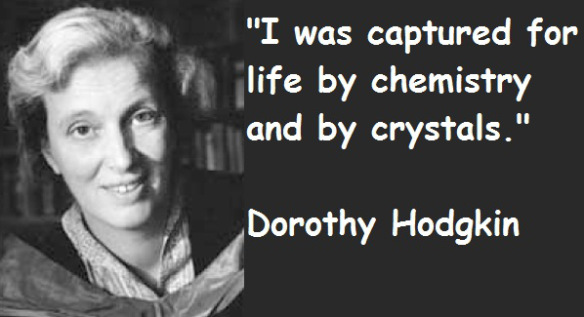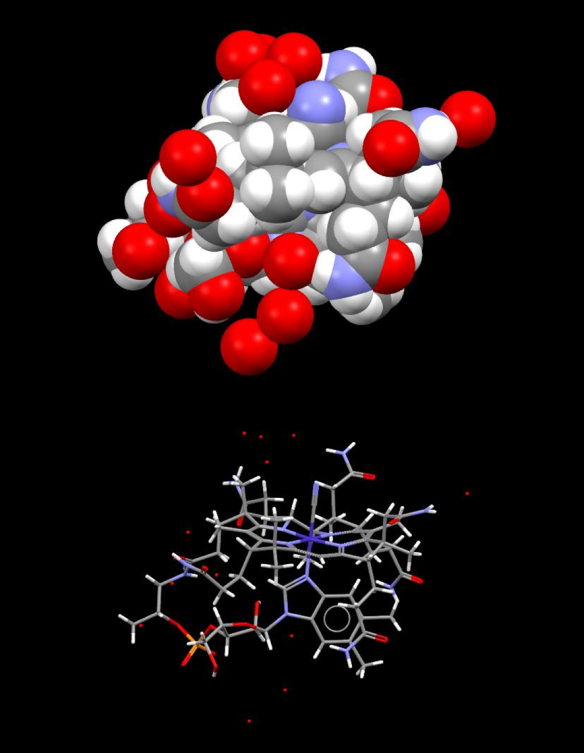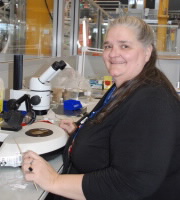Dorothy Crowfoot Hodgkin and the structure of Vitamin B12
Today is the birthday of Dorothy Crowfoot Hodgkin OM FRS who was awarded the 1964 Nobel Prize for her determinations by X-ray techniques of the structures of important biochemical substances.

What does it look like?

A space filling model of Vitamin B12 (cyano-cobalamin) (top) – and a "capped stick" representation of the same molecular structure (red= oxygen, grey= carbon, white = hydrogen, blue = cobalt, mauve = nitrogen, orange = phosphorus). Both structures depict the molecule in the same orientation – note the ease of access to the CN group bound at the top of the corrin ring – the reactive position of the molecule. Isolated red crosses or spheres are waters of crystallization. (coordinates used from DOI: 10.1039/c003378b)
What is it and how was the structure found?
This is Vitamin B12.
A vitamin is an organic compound vital to the nutrition of an organism. For any particular organism if the substance cannot be synthesized in sufficient (but very small) amounts, the vitamin must then be obtained from the diet. For instance, Vitamin D is a vitamin in humans because in certain circumstances, particularly low exposure to UV radiation, the normal synthesis of the substance does not occur and it must be consumed from dietary sources to meet metabolic requirements.
Vitamin B12 is chemically the most complex vitamin with a group of closely related substances functioning in the organism to provide the necessary source of cobalamin to vital enzymatic pathways of the metabolism. The recommended dietary intake in humans varies but is in the range of 1-3 micrograms (millionths of a gram) per day. Vitamin B12 deficiency can result either from an inadequate dietary intake, or from conditions in which the ability to absorb the nutrient is diminished. Biosynthesis of vitamin B12 only occurs in bacteria and archaea and passes into the food chain via bacterial symbiosis.
The common features of the Vitamin B12 group of compounds are (i) the corrin ring (similar to the porphyrin http://en.wikipedia.org/wiki/Porphyrin ring which binds to the metals present in haem, chlorophyll and cytochrome) which has (ii) a cobalt atom bound in its centre. (iii) One of the carbon atoms on the "outside" of the corrin ring carries a long chain of atoms ending in a dimethylbenzimidazole group which joins on to the cobalt through one of its nitrogen atoms on one side of the corrin ring and, on the other side of the corrin, a sixth substituent bonds to the cobalt atom – this is the site of the biological reactivity of Vitamin B12 and can be occupied by hydroxyl (-OH), methyl (-CH3), cyano (-CN) or 5'-deoxyadenosyl (via its C5' atom). All of these compounds form crystals which are deep red in colour.
The complete structure of vitamin B12 was determined by Dorothy Hodgkin and her collaborators by means of X-ray crystallographic methods. Using structures from fragments and combining knowledge of the chemistry and with access to early computer based Fourier methods, the structure was fully revealed. It is interesting to note the sharing of information which went on between the crystallographic groups and the chemists who were engaged in studying the structure. The documents demonstrate that the two different approaches were to be published simultaneously and Dorothy maintained an inclusive and generous approach to publication of this important structure. Dorothy learned that Alexander Todd (Nobel Prize for Chemistry 1957) had agreed to present a talk about "some new nitrogen-containing compounds" at a meeting of the Chemical Society which he had not mentioned to Dorothy when he was in Oxford a day or two prior to this for the purpose of discussing the publication of the structure. When Dorothy got wind of this talk, she attended, and, finding that he was announcing the structure, at the end of the talk Dorothy stood up and explained how it had been done. After this occurrence, Dorothy insisted that members of her crystallographic group went wherever Todd was speaking so that they could give a comment at the end.
A study designed to isolate the substance in liver which cured anaemia in dogs (iron), along the way revealed the presence of a different substance which cured pernicious anaemia in humans. For several years sufferers of pernicious anaemia were required to consume large amounts of raw liver or drink "liver juice" to treat their condition. The 1934 Nobel Prize in Physiology or medicine was awarded to Whipple, Minot and Murphy for their work in pointing the way to a treatment for this condition. In 1928 Edwin Cohn prepared an extract that was 50-100 times more effective in the treatment of the disease than raw liver products and together these discoveries led to the identification of the group of compounds known as Vitamin B12.






